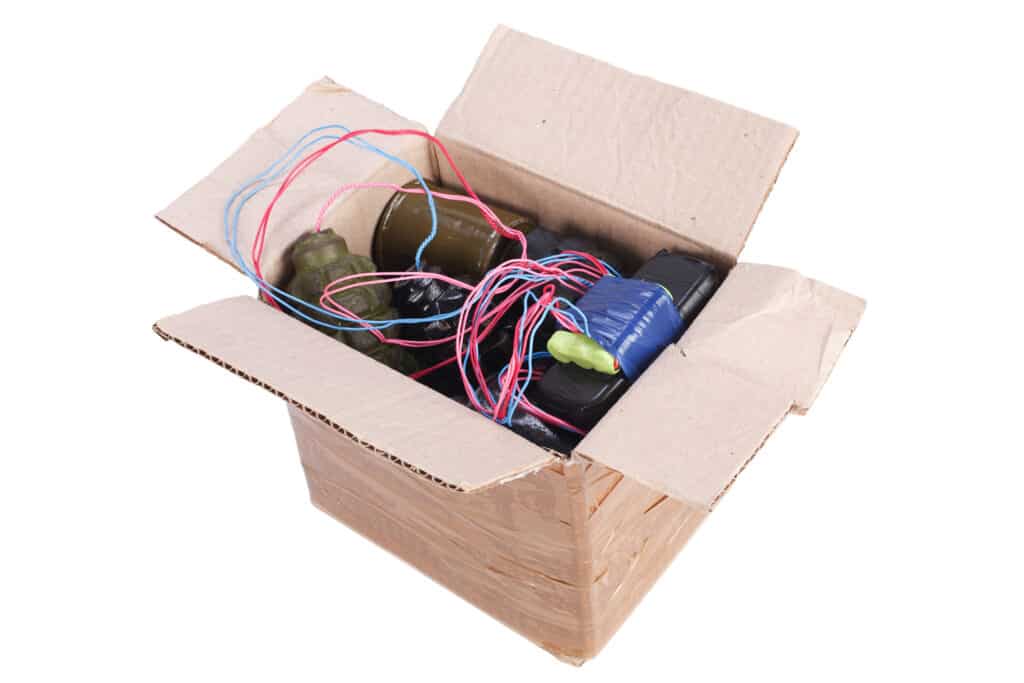Dangerous mail incidents have been a continuing concern for schools for quite some time.
These incidents often involve the delivery of mail containing harmful or potentially dangerous substances that can cause harm to the recipients and the school environment.
As the threat of dangerous mail persists, educational institutions must remain vigilant in safeguarding their students and staff members.
The United States Postal Inspection Service’s (USPIS) Dangerous Mail Investigations Unit handles an average of 10 dangerous mail incidents every day, with some of these incidents taking place in schools.
The history of such incidents reveals a concerning pattern of criminals exploiting mail services to threaten or cause harm to school communities.
By understanding the historical context and nature of these incidents, schools can better prepare and respond to any future threats posed by dangerous mail.
Historical Context of Dangerous Mail Incidents
Early Incidents
In the early years of the 21st century, dangerous mail incidents began to gain attention in the United States, particularly in educational institutions.
One of the most significant events in the history of dangerous mail threats occurred in 2001, with the anthrax attacks targeting various media outlets and government offices.
Although these attacks did not directly target schools, they heightened awareness of the potential risks posed by hazardous materials sent through the mail system.
During this period, schools across the country experienced a growing number of incidents involving mail threats.
Copycat incidents were prolific in the days, weeks, months, and years after this incident.
Throughout the early years, incidents varied in their nature, with some involving threatening letters, while others contained suspicious substances, typically white powder.
Recent Developments and Trends
In recent years, dangerous mail incidents have continued to evolve, with an increase in the overall number of reported cases.
One notable case in the history of dangerous mail incidents occurred in 2018, when a man from Texas sent over 500 white powder hoax letters to schools, government offices, and U.S. embassies.
Hong Minh Truong’s actions caused widespread panic and disruption, with many schools and offices being evacuated and emergency responders, including myself, being called in to investigate suspicious packages.
This case highlights the ongoing threat of dangerous mail incidents to educational institutions and the need for continued vigilance and preparedness.
The impact of such incidents can be significant, causing disruption to daily operations, loss of instructional time, and emotional distress for students, staff, and families.
In response to incidents like these, some schools have implemented updated protocols and increased security measures to better protect their communities.
Comprehensive mail screening procedures, specialized screening devices, and increased awareness and training for staff are just a few examples of the measures being taken to mitigate the threat of dangerous mail incidents.
While the threat of dangerous mail incidents continues to evolve, educational institutions must remain vigilant and proactive in their efforts to ensure the safety and security of their students, staff, and visitors.
By staying informed about emerging threats and best practices in mail security, schools can better prepare for and respond to potential incidents, ultimately helping to minimize the impact on their communities.
Types and Case Studies of Dangerous Mail Incidents
Dangerous mail incidents in schools can take various forms, ranging from bomb threats to hoaxes and extortion.
Bomb and Explosive Threats
Bomb and explosive threats are a significant concern for school officials, as they pose a severe risk to the safety of students, staff, and property.
There have been instances of suspicious mail items being sent to educational institutions containing components resembling explosive devices.
These are typically designed to cause disruptions since they have to be handled as real devices by first responders.
Biological, Chemical, and Radiological Attacks

Schools have also been targeted with mail containing hazardous substances, including biological, chemical, and radiological agents.
In 2020, dangerous mail incidents involving powders like ricin or fentanyl were present in 38% of the cases.
Hoaxes and Extortion
Hoaxes and extortion are the most common types of dangerous mail incidents targeting schools.
These incidents may involve the following elements:
- Letters or packages containing harmless substances like white powders, falsely claiming to be hazardous biological or chemical agents
- Messages threatening violence, with a demand for money or actions to prevent the threatened harm
- Anonymous threatening letters or emails, with no clear motive or threat
In some cases, hoax threats may be intended to cause disruption, scare recipients, and waste law enforcement resources.
While these incidents might not involve actual weapons or hazardous substances, they can still have a substantial emotional impact on the recipients and the school community.
By understanding the various types of dangerous mail incidents and their impact on schools, officials and law enforcement can better respond to and mitigate the risks associated with these threats.
Education and proper mail-handling procedures are essential for ensuring the safety and well-being of school communities.
Law Enforcement and Prevention Measures
United States Postal Inspection Service (USPIS)
The United States Postal Inspection Service (USPIS) plays a critical role in ensuring the safety of schools from dangerous mail incidents.
With an extensive history of investigating and preventing such threats, the USPIS continually evolves its methods to address the changing nature of security risks.
The agency’s forensic lab and Dangerous Mail Investigations Unit have been instrumental in identifying and mitigating potential hazards stemming from mailed items.
Collaboration with Federal Agencies
Collaboration between the USPIS and other federal agencies such as the FBI and ATF has been essential to ensuring a comprehensive approach to school safety.
These partnerships enable the sharing of resources, intelligence, and expertise to better combat potential threats.
The Department of Education supports these efforts through the National Center for Education Statistics by maintaining data on school crime and safety, which can inform the development of prevention strategies across all involved agencies.
School Administrators and Security Measures
School administrators have a crucial role in maintaining safe educational environments.
Policies and procedures must be in place to minimize the risk of dangerous mail incidents. Some of these measures include:
- Establishing a clear chain of command for reporting incidents.
- Providing training and awareness programs for staff and students.
- Implementing physical security features such as secure mailrooms and surveillance equipment.
- Partnering with local law enforcement, such as school resource officers, to enhance on-site security.
The involvement of school administrators in the effort to prevent dangerous mail incidents is vital to ensuring the overall safety of students and staff within their institutions.
By working closely with law enforcement and federal agencies, schools can maintain the highest level of protection against evolving security threats.
Understanding Dangerous Mail Risks
Evolving Threats and Vulnerabilities
Dangerous mail incidents have evolved over time, posing significant risks not only to their specific targets but also to the broader community.
In schools, the presence of dangerous mail has resulted in various consequences, ranging from minor disruptions to major incidents.
Research indicates that a wide range of criminal activities has contributed to the evolution of dangerous mail threats.
Examples include mail bombs, incendiary devices, and the use of powders or liquids to cause harm.
Mitigation Strategies
To minimize the risks associated with dangerous mail, it is crucial for schools to develop and implement effective mitigation strategies. These may include:
- Developing a clear chain of custody for mail handling and delivery
- Installing surveillance cameras near curbside drop boxes and mailrooms
- Training staff to recognize suspicious packages or mail items
- Collaborating with local law enforcement and postal inspection services for guidance and support
Moreover, raising awareness among the school community about the possible dangers associated with mail and packages can help in early detection and prevention of incidents.
By continuously updating security measures and collaborating with relevant authorities, schools can better protect their students, staff, and communities from the risks associated with dangerous mail.
Nationwide Perspective and Data Analysis
Comparing School Incidents and Other Public Spaces
When comparing dangerous mail incidents in schools to other public spaces, it’s important to consider the wider context and potential impact of these events.
Schools, in particular, are sensitive environments, where the safety of students and staff is of paramount importance.
In 2020, several hundred mail-borne incidents were reported to have affected not only schools but also other public spaces and buildings.
These incidents can be highly disruptive, with threats often necessitating evacuations and the deployment of emergency responders.
The 2019 Explosives Incident Report from the Threat Data Center highlighted that such incidents not only have grave implications for public safety but also bear significant economic costs.
While national statistics and data provide valuable insights into the scale and nature of dangerous mail incidents across the country, it is essential for school administrators to maintain a proactive approach to safeguarding their institutions.
Collaboration with local law enforcement agencies and sharing best practices can help ensure that schools remain adequately prepared to handle any potential threats.
Taking a nationwide perspective on dangerous mail incidents in schools highlights the importance of ongoing diligence and vigilance in maintaining the safety and well-being of students and staff.
Effective communication and cooperation among schools, law enforcement agencies, and other stakeholders is critical to staying ahead of emerging threats and providing a secure learning environment for all.
Final Thoughts
Dangerous mail incidents in schools have been a troubling issue for quite some time.
In 2020, parcels made up 63% of all threats, with letters accounting for 32% and the remaining 5% unidentified.
This is a significant concern for educational institutions and authorities alike as they strive to maintain a safe learning environment.
Key factors in addressing dangerous mail incidents include:
- Preventive measures like policies, procedures, and screening technology
- Increased collaboration among schools, USPS, and law enforcement agencies
- Regular training on mail screening and suspicious mail indicators
By focusing on these factors, schools can work together with postal services and law enforcement to reduce the occurrence of dangerous mail incidents and ensure a safe learning environment for students.
It is crucial for all parties involved to remain vigilant and informed, as continuous improvement is necessary to stay ahead of potential threats.
Take action now to protect your students and staff by reaching out to Risk Strategy Group for consulting and dangerous mail recognition training. Don’t wait until it’s too late – prioritize safety and security today. Contact Risk Strategy Group to learn more.








